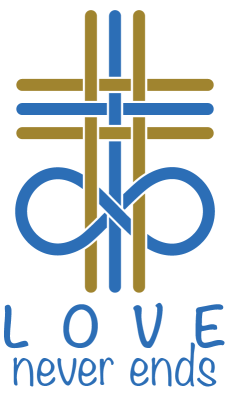
| a series by Dick Ficter, parishioner with Rev. Dina |
| February 7, 2024 |
In looking into the type of crosses there are I came across the Episcopal Church Service Cross. This was at the time that Deacon Susie was completing her service with us, and I thought what a great gift for her. A Deacon service cross. Some of you may recall Paul Harvey, a radio broadcaster, who had the famous line, and now the rest of the story. It was not long before I learned that the Episcopal Service Cross was for those who served in the military service. I never served, but my eldest brother, Jack, served with the 6th Infantry Division in the Philippines during World War II, and I was interested to learn more about this cross and its history. The following is a picture of the current cross and some of its history: |

The Episcopal Church War Commission
As America mobilized for The Great War, her people rallied to her defense. Among those to come to her aide, was the Episcopal Church. In September 1917, the church created the Episcopal Church War Commission to help serve the religious needs of Episcopalian men who were fighting in the service of their beloved country.
| The Commission raised money to supply its chaplains with portable altars, prayer books, hymnals, vestments, and Bibles needed for ministry. |
| Desiring to equip its fighting men with a personal reminder of their faith, the Commission called upon Mrs. James DeWolf Perry—the wife of the Rhode Island Bishop and chief of Red Cross chaplains in France from 1918 to 1919— to obtain designs for an Episcopal cross that could be worn by Episcopalian soldiers. Historical Note: The DeWolf family was the largest slave-trading family in U.S. history making The Episcopal Church over 15 years ago examine its complicity with slavery. Want to know more about the DeWolf family? Go to: Traces of the Trade. Want to learn more about the Church’s work on racism and the work of Becoming Beloved Community? Go to: Sacred Ground – The Episcopal Church. |
| Mrs. Perry approached the office of renowned American architect, Bertram Goodhue, with the challenge of designing the Episcopal medallion. Mrs. Perry provided Goodhue’s designers with several guidelines: first, the pendant should avoid sharp points; second, the design should be anchored by the ancient Crusader’s Cross, which is composed of five crosses symbolizing the five wounds of Christ; third, it should have engraved upon it “Christ Died for Thee,” a quotation from the Service of Holy Communion found within the Book of Common Prayer: “Take and eat this in remembrance that Christ died for thee, and feed on him in thy heart by faith, with thanksgiving.”; and fourth, “The Church War Cross” was to be inscribed across the back of the medallion. [The same front design was used in World War II and with the current cross but “thee” has been replaced with “you” and the inscription on the back is now Episcopal Church Service Cross. After all, service is service.] |

The Crusader’s Cross
Originally known as the Jerusalem Cross and incorporated into the Episcopal Service Cross, the Crusader’s Cross first appeared in the Latin Kingdom of Jerusalem, the First Crusade state established by Godefroi de Bouillon in 1099. The kingdom’s coat-of-arms, the Jerusalem Cross, would later be carried on the shields, banners, and coats of the Crusaders from England, France, Germany, Italy, and Spain, and so became identified as the Crusader’s Cross.
| The Kingdom of Jerusalem was a Crusader state established in the Levant in 1099 after the First Crusade. The Levant is an approximate historical geographical term referring to a large area in the Eastern Mediterranean region of West Asia. At its height, the kingdom controlled a territory that included modern-day Israel, the Palestinian territories, Jordan, and Lebanon, as well as parts of Syria and Turkey. The First Military Cross The Church War Cross became the first cross to be approved for use by the United States military. Portions of the above were from RelicRecord.com Updates. Now for something I see every time I am attending Epiphany from my designated seat. It is in the banner along the right-side wall, facing the altar and which contains the Greek letters; Chi Rho as follows: |

The Chi Rho (☧, English pronunciation /ˈkaɪ ˈroʊ/; also known as Chrismon) is one of the earliest forms of the Christogram, formed by superimposing the first two (capital) letters—chi and rho (ΧΡ)—of the Greek word ΧΡΙΣΤΟΣ (Christos) in such a way that the vertical stroke of the rho intersects the center of the chi. (Source: Wikipedia)
| Chi Rho has also been interpreted as “with this sign comes victory”. These are only some of the crosses found interesting for this message and there are many others which are important, and you may find interesting. |
| Do you have any questions for The Camel? Submit them to You can email your questions clergy@epiphanyec.org. Your name will be kept anonymous. |

| God Loves You. No Exceptions. Sunday, 2/11: Scouting Sunday & Newcomer’s Gathering Tuesday, 2/13 – Shrove Tuesday – Pancake Supper, Crafts. & Bounce House, 5:30pm – 7pm, donations welcome Wednesday, 2/14 – Ash Wednesday Communion with Imposition of Ashes: – 7:30am (Chapel), Noon (Chapel), 7:00pm (Chapel) Ashes to Go: 1pm outside Door 1 |


